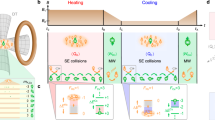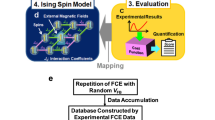Abstract
A current induces forces on atoms inside the conductor that carries it1. It is now possible to compute these forces from scratch, and to perform dynamical simulations of the atomic motion under current2,3,4,5,6. One reason for this interest is that current can be a destructive force—it can cause atoms to migrate, resulting in damage and in the eventual failure of the conductor. But one can also ask, can current be made to do useful work on atoms? In particular, can an atomic-scale motor be driven by electrical current7,8,9, as it can be by other mechanisms10,11,12,13? For this to be possible, the current-induced forces on a suitable rotor must be non-conservative, so that net work can be done per revolution. Here we show that current-induced forces in atomic wires are not conservative and that they can be used, in principle, to drive an atomic-scale waterwheel.
This is a preview of subscription content, access via your institution
Access options
Subscribe to this journal
Receive 12 print issues and online access
$259.00 per year
only $21.58 per issue
Buy this article
- Purchase on Springer Link
- Instant access to full article PDF
Prices may be subject to local taxes which are calculated during checkout


Similar content being viewed by others
References
Sorbello, R. S. Theory of electromigration. Solid State Phys. 51, 159–231 (1997).
Di Ventra, M., Pantelides, S. T. & Lang, N. D. Current-induced forces in molecular wires. Phys. Rev. Lett. 88, 046801 (2002).
Brandbyge, M. et al. Origin of current-induced forces in an atomic gold wire: a first-principles study. Phys. Rev. B 67, 193104 (2003).
Todorov, T. N., Hoekstra, J. & Sutton, A. P. Curent-induced embrittlement of atomic wires. Phys. Rev. Lett. 86, 3606–3609 (2001).
Verdozzi, C., Stefanucci, G. & Almbladh, C.-O. Classical nuclear motion in quantum transport. Phys. Rev. Lett. 97, 046603 (2006).
McEniry, E. J. et al. Dynamical simulation of inelastic quantum transport. J. Phys.: Condens. Matter 19, 196201 (2007).
Seideman, T. Current-driven dynamics in molecular-scale devices. J. Phys.: Condens. Matter 15, R521–R549 (2003).
Král, P. & Seideman, T. Current-induced rotation of helical molecular wires. J. Chem. Phys. 123, 184702 (2005).
Bailey, S. W. D., Amanatidis, I. & Lambert, C. J. Carbon nanotube electron windmills: A novel design for nanomotors. Phys. Rev. Lett. 100, 256802 (2008).
Ross Kelly, T., De Silva, H. & Silva, R. A. Unidirectional rotary motion in a molecular system. Nature 401, 150–152 (1999).
Koumura, N. et al. Light-driven monodirectional molecular rotor. Nature 401, 152–155 (1999).
Fennimore, A. M. et al. Rotational actuators based on carbon nanotubes. Nature 424, 408–410 (2003).
Wang, B. & Král, P. Chemically tunable nanoscale propellers of liquids. Phys. Rev. Lett. 98, 266102 (2007).
Di Ventra, M., Chen, Y.-C. & Todorov, T. N. Are current-induced forces conservative? Phys. Rev. Lett. 92, 176803 (2004).
Sutton, A. P. & Todorov, T. N. A Maxwell relation for current-induced forces. Mol. Phys. 102, 919–925 (2004).
Lou, L., Schaich, W. L. & Swihart, J. C. Calculations of the driving force of electromigration in hcp metals: Zn, Cd, Mg. Phys. Rev. B 33, 2170–2178 (1986).
Stamenova, M., Sanvito, S. & Todorov, T. N. Current-driven magnetic rearrangements in spin-polarized point contacts. Phys. Rev. B 72, 134407 (2005).
Ehrenfest, P. Bemerkung über die angenäherte Gültigkeit der klassischen Mechanik innerhalb der Quantenmechanik. Z. Phys. 45, 455–457 (1927).
Horsfield, A. P. et al. Power dissipation in nanoscale conductors: classical, semi-classical and quantum dynamics. J. Phys.: Condens. Matter 16, 3609–3622 (2004).
Todorov, T. N. Tight-binding simulation of current-carrying nanostructures. J. Phys.: Condens. Matter 14, 3049–3084 (2002).
Sutton, A. P. et al. A simple model of atomic interactions in noble metals based explicitly on electronic structure. Phil. Mag. A 81, 1833–1848 (2001).
Acknowledgements
We acknowledge valuable discussions with A. J. Fisher, J. Hoekstra, A. P. Sutton and D. Vanderbilt. This work was funded by the Engineering and Physical Sciences Research Council (EP/C006739/1), and made use of HPCx, the UK national high-performance computing service (EPCC, University of Edinburgh; STFC Daresbury Laboratory; EPSRC).
Author information
Authors and Affiliations
Corresponding author
Rights and permissions
About this article
Cite this article
Dundas, D., McEniry, E. & Todorov, T. Current-driven atomic waterwheels. Nature Nanotech 4, 99–102 (2009). https://doi.org/10.1038/nnano.2008.411
Received:
Accepted:
Published:
Issue Date:
DOI: https://doi.org/10.1038/nnano.2008.411
This article is cited by
-
Machine learning nonequilibrium electron forces for spin dynamics of itinerant magnets
npj Computational Materials (2023)
-
Enhanced energy harvesting near exceptional points in systems with (pseudo-)PT-symmetry
Communications Physics (2021)
-
Heat dissipation in quasi-ballistic single-atom contacts at room temperature
Scientific Reports (2019)
-
Nanoscale locomotion without fuel
Nature (2015)
-
Motion Driven by Strain Gradient Fields
Scientific Reports (2015)



